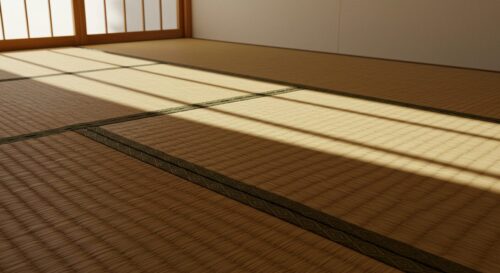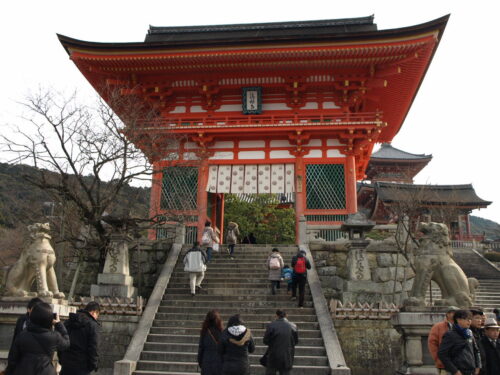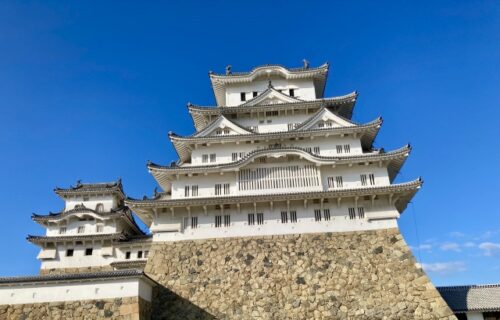The Enduring Legacy of Senso-ji Temple: Its Main Hall and Five-Story Pagoda as Historic Buildings
2025年10月20日
Dive into the rich tapestry of Senso-ji Temple, Tokyo’s oldest temple, to uncover the profound history and architectural brilliance of its two most iconic structures: the Main Hall and the Five-Story Pagoda. This article will illuminate why these magnificent edifices are celebrated as enduring historic buildings, offering readers a comprehensive understanding of their origins, their remarkable resilience through centuries of challenges, and their spiritual and cultural significance within Japan. You will gain insight into the intricate architectural features that define each structure, the symbolism embedded in the Five-Story Pagoda, and the compelling narratives of their original construction, destruction, and faithful reconstruction, solidifying their status as cherished landmarks in the heart of Asakusa.
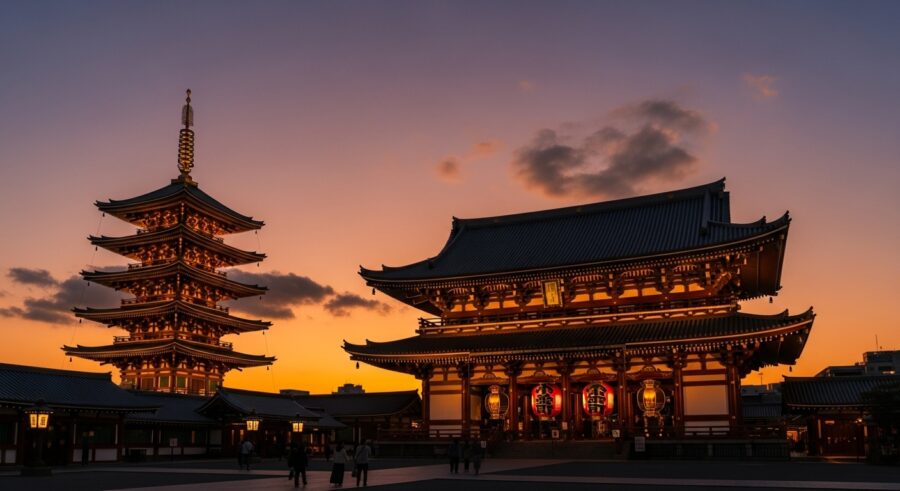
目次
- 1 Introduction to Senso-ji Temple’s Enduring Legacy
- 2 The Founding and Early History of Senso-ji Temple
- 3 The Founding and Early History of Senso-ji Temple
- 4 Senso-ji Temple’s Main Hall: A Sacred Core
- 5 Senso-ji Temple’s Five-Story Pagoda: A Symbol of Buddhist Cosmology
- 6 The Main Hall and Five-Story Pagoda as Historic Buildings: Enduring Legacy
- 7 Surrounding Historic Structures: Kaminarimon and Nakamise-dori
- 8 Conclusion
Introduction to Senso-ji Temple’s Enduring Legacy
Nestled in the vibrant district of Asakusa, Tokyo, Senso-ji Temple stands as a profound testament to Japan’s rich spiritual and cultural heritage. As Tokyo’s oldest Buddhist temple, its origins are steeped in legend, tracing back to 628 AD when two fishermen, the Hinokuma brothers, are said to have discovered a statue of Kannon, the Bodhisattva of Mercy, in the Sumida River. This auspicious event led to the temple’s establishment, which was formally completed in 645 AD, marking the beginning of a legacy spanning over 1,300 years.
Senso-ji Temple, also affectionately known as Asakusa Kannon Temple, is not merely a place of worship but a bustling cultural landmark that draws an astounding 30 million visitors annually, making it one of the most widely visited religious sites in the world. Its enduring appeal lies in its deep historical roots, its role as a spiritual heart for millions, and its magnificent architectural ensemble, particularly its revered Main Hall (Hondo) and the iconic Five-Story Pagoda (Goju-no-to).
These two central structures, while having undergone multiple reconstructions throughout their history—most notably after their destruction during the World War II firebombing of Tokyo—continue to embody the resilience and unwavering faith of the Japanese people. They serve as powerful symbols of Buddhist cosmology and traditional Japanese craftsmanship, preserving an ancient aesthetic amidst a modern metropolis. This article delves into the historical significance and architectural grandeur of Senso-ji Temple’s Main Hall and Five-Story Pagoda, exploring their enduring legacy as invaluable historic buildings.
Key Facts About Senso-ji Temple
| Feature | Detail |
|---|---|
| Official Name | Kinryū-zan Sensō-ji (金龍山浅草寺) |
| Also Known As | Asakusa Kannon Temple |
| Location | Asakusa, Taito-ku, Tokyo, Japan |
| Founding Legend | Statue of Kannon found in Sumida River in 628 AD |
| Completion Date | 645 AD |
| Primary Deity | Kannon (Bodhisattva of Mercy/Compassion) |
| Annual Visitors | Over 30 million |
| Significance | Oldest temple in Tokyo, major cultural and spiritual landmark |
For more detailed historical information, you can visit the official Senso-ji Temple website or explore resources like Japan Guide’s Sensoji Temple page and Go Tokyo’s overview.
The Founding and Early History of Senso-ji Temple
The origins of Senso-ji Temple, Tokyo’s oldest temple, are steeped in a rich tapestry of legend and historical accounts, dating back to the early 7th century. Its establishment marks a pivotal moment in the spiritual and cultural development of the Asakusa area and indeed, of Japan itself.
The Miraculous Discovery of the Kannon Statue
The foundational legend of Senso-ji centers around a miraculous event that is said to have occurred in the year 628 AD. According to tradition, two brothers, Hinokuma Hamanari and Hinokuma Takenari, were fishing in the Sumida River. Instead of fish, they repeatedly pulled up a small, golden statue. Initially perplexed, they discarded it back into the river, only for it to reappear in their nets. Eventually, they showed the mysterious find to a local village head, Hajino Nakamoto, who immediately recognized the statue as an image of Kannon Bodhisattva (Avalokiteshvara), the Buddhist deity of mercy and compassion.
Recognizing the profound sanctity of the discovery, Hajino Nakamoto dedicated his own home as a humble temple to enshrine the sacred Kannon statue, allowing villagers to worship it. This initial act of devotion laid the groundwork for what would become the grand Senso-ji Temple complex.
Establishment and Early Development of the Temple
Following the statue’s discovery, the formal establishment of Senso-ji Temple is generally attributed to the monk Shokai in 645 AD. He is credited with constructing the first temple building to house the revered Kannon image, thus transforming Hajino Nakamoto’s private shrine into a public place of worship.
Over the ensuing centuries, Senso-ji grew in prominence and influence. Its strategic location in Asakusa, near the Sumida River, facilitated its development as a significant pilgrimage site. The temple attracted devotees from all walks of life, including powerful regional lords and shoguns, who offered patronage and contributed to its expansion. This early support helped solidify Senso-ji’s status as a spiritual beacon and a center for Buddhist learning and practice in the Kanto region.
Key Figures and Dates in Senso-ji’s Early History
The table below summarizes the principal figures and events associated with the founding and early development of Senso-ji Temple:
| Year | Event / Figure | Significance |
|---|---|---|
| 628 AD | Hinokuma Hamanari and Hinokuma Takenari | Legendary discovery of the Kannon Bodhisattva statue in the Sumida River. |
| 628 AD (approx.) | Hajino Nakamoto | Identified the Kannon statue and enshrined it in his home, creating the first rudimentary place of worship. |
| 645 AD | Monk Shokai | Credited with the official founding of Senso-ji Temple and the construction of its first formal temple building. |
| 7th – 12th Centuries | Various Patrons | Early growth and expansion of the temple complex, supported by influential figures and pilgrims. |
The Kannon statue itself, known as the “Asakusa Kannon,” is considered a “hibutsu” (secret Buddha) and is never displayed to the public, adding to its mystique and reverence. This tradition of non-disclosure has been maintained since its enshrinement, underscoring the profound spiritual significance of this foundational artifact.
The early history of Senso-ji Temple is thus a testament to enduring faith, beginning with a serendipitous discovery and evolving into one of Japan’s most cherished and historically significant Buddhist sites.
Sources:
Note: The specific details and exact dates of ancient legends can vary slightly across different historical accounts, but the core narrative remains consistent.
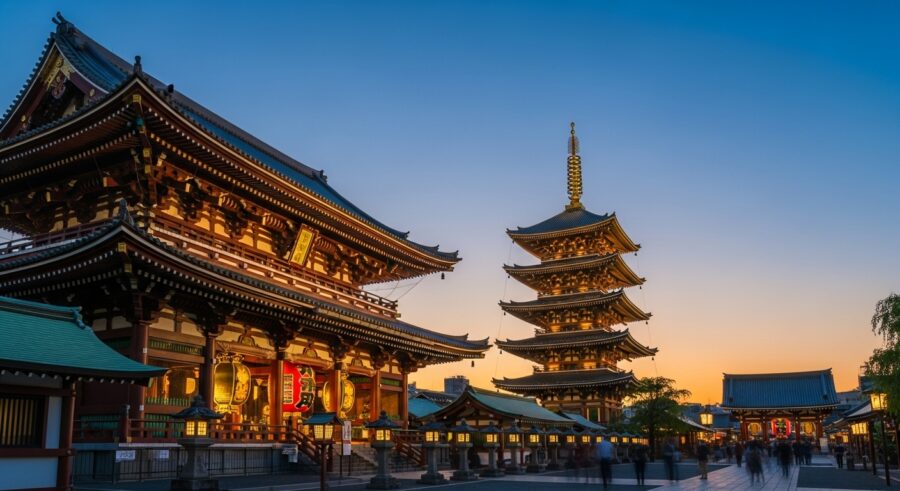
The Founding and Early History of Senso-ji Temple
The origins of Senso-ji Temple, Tokyo’s oldest temple, are steeped in a rich tapestry of legend and historical accounts, dating back to the early 7th century. Its establishment marks a pivotal moment in the spiritual and cultural development of the Asakusa area and indeed, of Japan itself.
The Miraculous Discovery of the Kannon Statue
The foundational legend of Senso-ji centers around a miraculous event that is said to have occurred in the year 628 AD. According to tradition, two brothers, Hinokuma Hamanari and Hinokuma Takenari, were fishing in the Sumida River. Instead of fish, they repeatedly pulled up a small, golden statue. Initially perplexed, they discarded it back into the river, only for it to reappear in their nets. Eventually, they showed the mysterious find to a local village head, Hajino Nakamoto (also known as Hajino Matsuchi or Haji no Nakatomo), who immediately recognized the statue as an image of Kannon Bodhisattva (Avalokiteshvara), the Buddhist deity of mercy and compassion.
Recognizing the profound sanctity of the discovery, Hajino Nakamoto dedicated his own home as a humble temple to enshrine the sacred Kannon statue, allowing villagers to worship it. This initial act of devotion laid the groundwork for what would become the grand Senso-ji Temple complex.
Establishment and Early Development of the Temple
Following the statue’s discovery, the formal establishment of Senso-ji Temple is generally attributed to the monk Shokai in 645 AD. He is credited with constructing the first temple building to house the revered Kannon image, thus transforming Hajino Nakamoto’s private shrine into a public place of worship.
Over the ensuing centuries, Senso-ji grew in prominence and influence. Its strategic location in Asakusa, near the Sumida River, facilitated its development as a significant pilgrimage site. The temple attracted devotees from all walks of life, including powerful regional lords and shoguns, who offered patronage and contributed to its expansion. This early support helped solidify Senso-ji’s status as a spiritual beacon and a center for Buddhist learning and practice in the Kanto region.
Key Figures and Dates in Senso-ji’s Early History
The table below summarizes the principal figures and events associated with the founding and early development of Senso-ji Temple:
| Year | Event / Figure | Significance |
|---|---|---|
| 628 AD | Hinokuma Hamanari and Hinokuma Takenari | Legendary discovery of the Kannon Bodhisattva statue in the Sumida River. |
| 628 AD (approx.) | Hajino Nakamoto (Haji no Nakatomo) | Identified the Kannon statue and enshrined it in his home, creating the first rudimentary place of worship. |
| 645 AD | Monk Shokai | Credited with the official founding of Senso-ji Temple and the construction of its first formal temple building. |
| 7th – 12th Centuries | Various Patrons | Early growth and expansion of the temple complex, supported by influential figures and pilgrims. |
The Kannon statue itself, known as the “Asakusa Kannon,” is considered a “hibutsu” (secret Buddha) and is never displayed to the public, adding to its mystique and reverence. This tradition of non-disclosure has been maintained since its enshrinement in 645 AD, underscoring the profound spiritual significance of this foundational artifact.
The early history of Senso-ji Temple is thus a testament to enduring faith, beginning with a serendipitous discovery and evolving into one of Japan’s most cherished and historically significant Buddhist sites.
Senso-ji Temple’s Main Hall: A Sacred Core
At the heart of the Senso-ji Temple complex stands the Main Hall, known in Japanese as the Hondo or Kannon-do, serving as the most sacred area where worshippers gather to pray to Kannon, the Buddhist goddess of mercy. This magnificent structure is central to the temple’s enduring spiritual significance and its rich history.
Original Construction and Early Incarnations of the Main Hall
The origins of Senso-ji Temple trace back to a legendary event in 628 AD when two fishermen brothers, Hinokuma Hamanari and Hinokuma Takenari, discovered a small golden statue of Kannon in the Sumida River. Despite repeatedly returning it to the water, the statue miraculously reappeared in their net. Recognizing its divine nature, the local chief, Haji no Matsuchi, converted his home into a small temple to enshrine the statue, marking the foundation of Senso-ji.
The earliest formal iteration of Senso-ji Temple, including a hall for Kannon, was completed in 645 AD by a Buddhist priest named Shokai. Following a revelation in a dream, Shokai decided to hide the statue from public view, a tradition that has been maintained ever since, with the original Kannon image remaining a “hibutsu” (hidden Buddha).
Throughout its long history, the Main Hall, like many other structures within the Senso-ji complex, faced numerous challenges, including destruction by fires and natural disasters. For instance, the Main Hall was rebuilt in 1649 with the assistance of the third Tokugawa shogun, Tokugawa Iemitsu, and managed to survive for almost 300 years, even enduring the Great Kanto Earthquake of 1923.
Reconstruction and Enduring Significance of the Main Hall
The Main Hall, a former National Treasure, suffered complete destruction during the devastating Tokyo air raids of March 10, 1945, during World War II. Its reconstruction became a crucial symbol of Tokyo’s rebirth and resilience after the war.
The current Main Hall was rebuilt with donations from followers across Japan, with construction beginning in 1951 and completing in October 1958. This modern incarnation was constructed in the same traditional style as its predecessor but utilized more robust materials, specifically ferroconcrete, to enhance its durability. In 2010, the traditional hip-and-gable roof of the Main Hall was further enhanced with lightweight titanium tiles.
Today, the Main Hall continues to be a vibrant center of worship, drawing approximately 30 million visitors annually, making Senso-ji one of the most visited religious sites globally. It stands as a testament to the enduring faith in Kannon and the temple’s profound cultural importance.
Architectural Features of Senso-ji Temple’s Main Hall
The Main Hall of Senso-ji Temple showcases distinctive architectural elements that reflect traditional Japanese Buddhist design, adapted for modern resilience. Its design incorporates both aesthetic beauty and functional sacred space.
| Feature | Description | Significance |
|---|---|---|
| Roof Style | Traditional hip-and-gable roof, retiled with lightweight titanium in 2010. | Contributes to the hall’s distinctive silhouette, noticeably tall compared to other temples, and ensures longevity. |
| Construction Material | Ferroconcrete (reinforced concrete), built in the same style as the previous wooden structure. | Provides enhanced fire resistance and structural integrity, crucial after its destruction in WWII. |
| Interior Division | Divided into the naijin (inner sanctum) and the gejin (outer sanctum). | The naijin houses the principal image of Kannon, kept hidden from public view, while the gejin is for worshippers. |
| Kannon Statue | The original golden statue, discovered in 628 AD, is enshrined in a miniature temple within the naijin and remains a “hibutsu” (hidden Buddha) since 645 AD. | The spiritual core of Senso-ji, dedicated to the Bodhisattva of compassion, Kannon. |
| Incense Burner (Jokoro) | Located near the main hall entrance, visitors waft smoke over themselves. | Believed to cleanse the body and spirit, promoting health and wisdom. |
| Decorations | Features Buddhist symbols such as lotus flowers and dragons, and vibrant colors like red and gold. | Enhances the sacred atmosphere and reflects traditional Japanese Buddhist artistry. |
While the inner sanctum housing the sacred Kannon statue is not accessible to the public, the intricate details and ornamentation of the hall’s exterior and accessible areas provide a profound visual and spiritual experience for visitors.
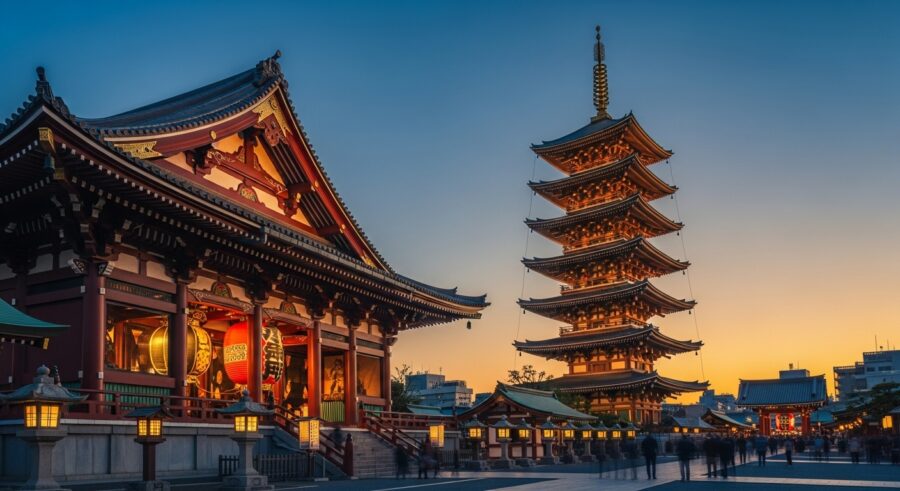
Senso-ji Temple’s Five-Story Pagoda: A Symbol of Buddhist Cosmology
Standing majestically within the precincts of Senso-ji Temple, the Five-Story Pagoda (Gojū-no-tō) is an iconic structure that not only captivates with its architectural beauty but also embodies profound Buddhist symbolism. It serves as a spiritual beacon and a testament to the temple’s enduring legacy through centuries of destruction and reconstruction.
Historical Development of the Five-Story Pagoda
The history of Senso-ji Temple’s Five-Story Pagoda dates back to 942 AD when it was first constructed by military commander Taira no Kinmasa. Throughout its long existence, the pagoda has faced numerous challenges, including destruction by fires and natural disasters, necessitating multiple rebuilds.
A significant reconstruction occurred in 1648 under the patronage of Tokugawa Iemitsu, the third shogun of the Tokugawa Shogunate, establishing it as a prominent landmark of Edo (old Tokyo) and Asakusa. However, this Edo-era masterpiece was tragically destroyed during the Great Tokyo Air Raid on March 10, 1945, amidst World War II, a fate shared by many of Tokyo’s historic structures.
The current Five-Story Pagoda, a symbol of resilience and rebirth, was reconstructed in 1973. Unlike its predecessors, this modern iteration was built using a steel frame and reinforced concrete, ensuring enhanced durability and earthquake resistance while faithfully replicating the traditional architectural aesthetics. Notably, its location was shifted to the left side when approaching the Main Hall, whereas it previously stood on the right. The pagoda underwent further renovations in 2017, ensuring its continued grandeur.
Its Role in the Senso-ji Temple Complex
The Five-Story Pagoda is one of the most recognizable structures within the Senso-ji complex, standing alongside the Kaminarimon (Thunder Gate) and the Main Hall as a central visual element. Its primary spiritual function is to house sacred relics. On its topmost floor, it enshrines Busshari (Buddha’s ashes), which were officially donated by the Isurumuniya Temple in Sri Lanka in 1966.
Beyond the reliquary, the pagoda also contains rooms at its base that house 100 statues of Kanzeon Bosatsu and more than 100,000 *ihai* tablets, which are memorial tablets inscribed with the posthumous Buddhist names of the deceased. While the interior is generally not open to the public, exceptions are made three times a year for those who have applied for “Eitai Kuyo,” a service for perpetual grave care, and their families. The pagoda, along with the Kaminarimon and Hozomon Gates, is beautifully illuminated at night, a practice that began in 2003, offering a mystical and captivating view after sunset.
Architectural Details and Symbolism of the Pagoda
The Five-Story Pagoda of Senso-ji Temple is an architectural marvel that embodies deep Buddhist cosmology. Standing at approximately 53.32 meters, it is considered the second-highest pagoda in Japan, after the one at Toji Temple in Kyoto.
The pagoda’s design, with its five distinct tiers, symbolizes the five elements of Buddhist cosmology: Earth, Water, Fire, Wind, and Void (or Space). Each tier represents one of these fundamental components of the universe, guiding observers on a symbolic journey towards enlightenment. This structural form, known as a pagoda, evolved from the Indian stupa, which traditionally served as a reliquary for the ashes of the Buddha.
A key architectural feature contributing to its resilience is the *shinbashira*, or central pillar structure. This innovative design provides significant earthquake resistance, a characteristic also famously employed in the construction of the Tokyo Skytree. The pagoda’s elegant design is further enhanced by intricate carvings and its vibrant vermilion hue, which stands out beautifully against the surrounding temple grounds.
| Feature | Detail | Significance |
|---|---|---|
| Height | Approximately 53.32 meters (about 18 stories) | One of the tallest pagodas in Japan |
| Number of Stories | Five | Represents the five elements of Buddhist cosmology (Earth, Water, Fire, Wind, Void) |
| Construction Material (Current) | Steel frame and reinforced concrete | Ensures modern durability and earthquake resistance |
| Central Pillar (Shinbashira) | Internal central pillar structure | Provides exceptional earthquake resistance, a traditional Japanese architectural technique |
| Contents | Buddha’s ashes (Busshari) on the top floor, 100 Kanzeon Bosatsu statues, and over 100,000 *ihai* tablets at the base | Serves as a sacred reliquary and memorial site |
The Main Hall and Five-Story Pagoda as Historic Buildings: Enduring Legacy
The Main Hall (Kannon-do Hall) and the Five-Story Pagoda of Senso-ji Temple stand as powerful testaments to Tokyo’s profound cultural and spiritual heritage. Despite numerous challenges throughout their long history, including devastating fires, earthquakes, and the extensive destruction during the 1945 Tokyo air raids, these iconic structures have been meticulously rebuilt, embodying an enduring legacy of resilience and devotion.
Symbols of Continuous Spiritual Practice and Cultural Preservation
Senso-ji Temple, Tokyo’s oldest temple, has maintained an unbroken tradition of Buddhist practice for nearly 1,400 years, making its principal structures central to Japan’s spiritual continuity. The Main Hall, the sacred core of the temple, enshrines the hidden statue of the Bodhisattva Kannon, the Goddess of Mercy, which has been the object of veneration since the temple’s legendary founding in 628 AD. Its continuous existence, even through multiple reconstructions, signifies the unwavering faith of generations.
Similarly, the Five-Story Pagoda, a prominent landmark, serves as a visual representation of Buddhist cosmology, with each level symbolizing the five elements of the universe: earth, water, fire, wind, and space. It also houses sacred relics, including Buddha’s ashes, gifted from Sri Lanka, further solidifying its spiritual importance. The repeated rebuilding of these structures underscores a deep national commitment to preserving traditional Japanese architecture and the cultural narratives embedded within them.
Architectural Resilience and Modern Preservation
While the original Main Hall was once designated a National Treasure before its destruction in World War II, both the current Main Hall and Five-Story Pagoda are post-war reconstructions, completed in 1958 and 1973, respectively. These modern iterations, while maintaining their traditional aesthetic, incorporate advanced architectural techniques, such as steel frames and reinforced concrete, to ensure greater resilience against natural disasters, notably earthquakes. For instance, the Main Hall now features a titanium tiled roof, offering enhanced durability while preserving its historic appearance. This blend of traditional design and modern engineering highlights a forward-thinking approach to heritage preservation.
The significance of these buildings extends beyond their religious function; they are vital cultural assets that draw approximately 30 million visitors annually, serving as a prominent symbol of Tokyo and a gateway to understanding Japan’s rich past. Their enduring presence fosters a connection to the Edo period (1603-1868), during which Senso-ji flourished under the patronage of the Tokugawa shogunate and became a cultural hub of the city.
Key Milestones in the Legacy of Senso-ji’s Main Hall and Five-Story Pagoda
| Structure | Original Construction
(Legendary/First Recorded) |
Significant
Reconstructions/Events |
Current Structure
Completed |
Enduring Significance |
|---|---|---|---|---|
| Main Hall (Kannon-do Hall) | 645 AD (first hall for Kannon) |
|
1958 | Sacred core enshrining the Kannon statue; continuous site of worship and pilgrimage. |
| Five-Story Pagoda | 942 AD by Taira no Kinmasa |
|
1973 | Symbol of Buddhist cosmology and resilience; houses Buddha’s ashes; a prominent landmark of Asakusa. |
The ongoing preservation and accessibility of the Main Hall and Five-Story Pagoda allow visitors from around the world to connect with Japan’s profound history and spiritual traditions. They stand not merely as ancient relics but as vibrant, living monuments to an enduring cultural legacy.
Surrounding Historic Structures: Kaminarimon and Nakamise-dori
Beyond the Senso-ji Temple’s revered Main Hall and Five-Story Pagoda, two other iconic structures, the Kaminarimon (Thunder Gate) and Nakamise-dori, serve as essential components of the temple complex and the Asakusa district’s rich historical tapestry. These sites not only act as gateways and arteries to the main temple but also embody centuries of Japanese culture, commerce, and spiritual devotion.
Kaminarimon: The Iconic Gateway to Senso-ji
The Kaminarimon, or “Thunder Gate,” stands as the majestic outer entrance to Senso-ji Temple and is widely recognized as a prominent symbol of Asakusa and the city of Tokyo itself. Its history dates back to 941 AD when it was first constructed by the military commander Taira no Kinmasa. Throughout its long existence, the gate has faced numerous destructions by fire and subsequent reconstructions. The current impressive structure was last rebuilt in 1960, largely due to a significant donation from Konosuke Matsushita, the founder of Matsushita Electric Industrial Company (now Panasonic).
The Kaminarimon’s architectural features are both grand and symbolic. It stands approximately 11.7 meters tall and 11.4 meters wide, covering an area of 69.3 square meters. The gate is instantly recognizable by its colossal red paper lantern, known as a chochin. This magnificent lantern measures 3.9 meters high, 3.3 meters wide, and weighs a substantial 700 kilograms. Inscribed with “Kaminarimon” on the front and “Matsushita Denki” on the back, its base features an intricate dragon-shaped carving, believed to enshrine a dragon that appeared when the Kannon Bodhisattva statue was first discovered, watching over the temple.
Flanking the gate are statues of powerful deities, acting as guardians of the temple. On the front, visitors are greeted by Fujin, the Shinto God of Wind, on the east side, and Raijin, the Shinto God of Thunder, on the west side. These statues, combining Edo period heads with Meiji period bodies, reflect a blend of historical craftsmanship. On the rear of the gate, facing towards Nakamise-dori, are the Buddhist dragon deities Tenryu and Kinryu, further emphasizing the syncretic religious traditions of Japan.
| Feature | Description |
|---|---|
| First Construction | 941 AD by Taira no Kinmasa |
| Current Structure Rebuilt | 1960, donated by Konosuke Matsushita (Panasonic) |
| Dimensions | 11.7m (height), 11.4m (width), 69.3 m² (area) |
| Giant Lantern (Chochin) | 3.9m (height), 3.3m (width), 700kg (weight); “Kaminarimon” on front, “Matsushita Denki” on back; dragon carving at base |
| Front Statues | Fujin (Wind God, east), Raijin (Thunder God, west) |
| Rear Statues | Tenryu (Heavenly Dragon God), Kinryu (Golden Dragon God) |
Nakamise-dori: A Historic Shopping Street
Immediately beyond the Kaminarimon stretches Nakamise-dori, one of Japan’s oldest and most vibrant shopping streets, leading directly to Senso-ji’s second gate, the Hozomon. This bustling pedestrian thoroughfare dates back to the Edo period (17th-18th centuries), originating as a collection of stalls catering to the increasing number of pilgrims visiting Senso-ji Temple. Over the centuries, Nakamise-dori has undergone several transformations, including rebuilding after the Great Kanto Earthquake of 1923 and the fires of World War II, yet it has consistently retained its traditional charm and historical significance.
The street extends for approximately 250 meters (820 feet) and is lined with around 89 shops, offering a unique blend of traditional Japanese culture and commerce. Visitors to Nakamise-dori can explore a wide array of goods, from exquisite traditional Japanese crafts like hand-painted fans, intricate woodblock prints, masks, dolls, and garments such as kimonos and yukata, to a delectable selection of local snacks. Popular culinary treats include ningyo-yaki (small cakes often filled with sweet red bean paste), crispy senbei rice crackers, kaminariokoshi (sweet puffed rice cakes), and Asakusa nori (seaweed). Many of these shops have been family-run for generations, preserving authentic craftsmanship and culinary traditions. The street’s atmosphere is further enhanced by seasonal decorations that adorn the shop roofs, reflecting various Japanese festivities throughout the year.
| Aspect | Details |
|---|---|
| Origin | Edo period (17th-18th centuries), serving pilgrims to Senso-ji Temple |
| Length | Approximately 250 meters (820 feet) |
| Number of Shops | Around 89 shops (e.g., 54 on east, 35 on west) |
| Typical Products | Traditional crafts (fans, kimonos, masks, woodblock prints), local snacks (ningyo-yaki, senbei, kaminariokoshi) |
| Significance | One of Japan’s oldest shopping streets, cultural experience, connects Kaminarimon to Hozomon |
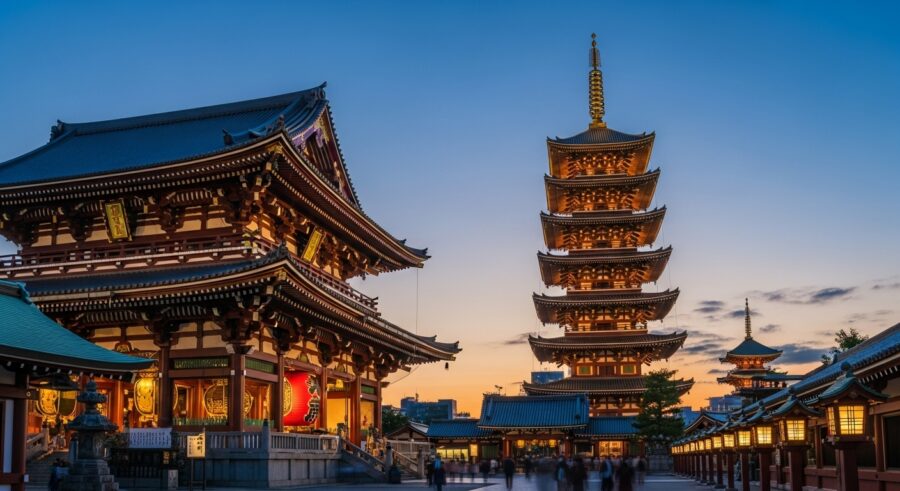
Conclusion
Senso-ji Temple, an iconic landmark in Asakusa, Tokyo, stands as a profound testament to Japan’s rich cultural and spiritual heritage. As Tokyo’s oldest temple, its history stretches back over 1,300 years, beginning with the legendary discovery of a Kannon statue in 628 AD. The temple complex, particularly its revered Main Hall (Hondo) and the majestic Five-Story Pagoda (Goju-no-to), embodies a remarkable story of resilience and unwavering faith, having been repeatedly rebuilt after numerous destructions by fires, earthquakes, and notably, the devastating Tokyo air raids of 1945.
The Main Hall, reconstructed in 1958, serves as the spiritual heart of Senso-ji, housing the sacred image of Kannon, the Bodhisattva of Compassion, and continuing to draw millions of worshippers annually. Adjacent to it, the Five-Story Pagoda, rebuilt in 1973, rises gracefully, symbolizing Buddhist cosmology and offering a visual anchor to the temple’s profound spiritual essence. These structures, though modern reconstructions, meticulously preserve the architectural traditions and aesthetic principles that have defined Senso-ji throughout its long existence, representing a living link to Japan’s past and an enduring commitment to its spiritual foundations.
The journey to the Main Hall and Five-Story Pagoda is itself an immersive cultural experience, guided by the impressive Kaminarimon (Thunder Gate) and the bustling Nakamise-dori. The Kaminarimon, with its colossal red lantern and guardian deities, acts as a symbolic threshold, welcoming visitors into a realm steeped in tradition. Beyond it, Nakamise-dori, one of Japan’s oldest shopping streets dating back to the Edo period, offers a vibrant passage filled with traditional crafts, souvenirs, and local delicacies, reflecting centuries of pilgrim culture and commerce. Together, these elements create a holistic experience that transcends mere sightseeing, inviting visitors to engage with a spiritual center that has adapted and thrived through the ages.
The reconstruction efforts after World War II underscore the profound importance of Senso-ji to the Japanese people, symbolizing Tokyo’s rebirth and the nation’s dedication to preserving its cultural identity.
| Structure | Year of Post-WWII Reconstruction |
|---|---|
| Main Hall (Kannondo Hall) | 1958 |
| Kaminarimon (Thunder Gate) | 1960 |
| Hozomon (Treasure House Gate) | 1964 |
| Five-Story Pagoda | 1973 |
With over 30 million visitors annually, Senso-ji remains not only the most widely visited religious site in the world but also a dynamic hub where ancient traditions meet modern life. Its Main Hall and Five-Story Pagoda are more than just historic buildings; they are powerful symbols of endurance, faith, and the continuous flow of Japanese culture, deeply embedded in the spiritual landscape of Tokyo and beyond.
For more information about our projects and craftsmanship, please visit our official website:
🌐 Sato Construction (Shizenya)
Watch our latest video on YouTube and see how we bring traditional Japanese architecture to life:
▶️ Sato Construction YouTube Video
